Items filtered by date: July 2025
Recognizing Symptoms of Ingrown Toenails
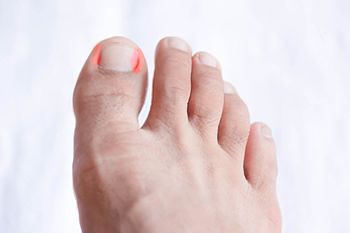
Ingrown toenails can cause significant discomfort, if left untreated. This condition develops when the edge of the toenail grows into the surrounding skin. People often notice redness and swelling surrounding the nail, along with tenderness when pressure is applied. Pain typically worsens when wearing shoes or walking for long periods of time. As the condition progresses, the skin near the nail may become warm and develop drainage or signs of infection. Some people may see pus or feel throbbing pain, especially if bacteria enters the area. The skin may also appear hardened or overgrown along the nail edge. Recognizing these symptoms early can help prevent more serious complications, including deeper infection or abscess. If you notice signs of an ingrown toenail, it is suggested you schedule an appointment with a podiatrist for proper care and appropriate treatment.
Ingrown toenails may initially present themselves as a minor discomfort, but they may progress into an infection in the skin without proper treatment. For more information about ingrown toenails, contact Gerard Skaziak, DPM of Lakeview Family Foot Care. Our doctor can provide the care you need to keep you pain-free and on your feet.
Ingrown Toenails
Ingrown toenails are caused when the corner or side of a toenail grows into the soft flesh surrounding it. They often result in redness, swelling, pain, and in some cases, infection. This condition typically affects the big toe and may recur if it is not treated properly.
Causes
- Improper toenail trimming
- Genetics
- Improper shoe fitting
- Injury from pedicures or nail picking
- Abnormal gait
- Poor hygiene
You are more likely to develop an ingrown toenail if you are obese, have diabetes, arthritis, or have any fungal infection in your nails. Additionally, people who have foot or toe deformities are at a higher risk of developing an ingrown toenail.
Symptoms
Some symptoms of ingrown toenails are redness, swelling, and pain. In rare cases, there may be a yellowish drainage coming from the nail.
Treatment
Ignoring an ingrown toenail can have serious complications. Infections of the nail border can progress to a deeper soft-tissue infection, which can then turn into a bone infection. You should always speak with your podiatrist if you suspect you have an ingrown toenail, especially if you have diabetes or poor circulation.
If you have any questions, please feel free to contact our offices located in Guntersville and Albertville, AL . We offer the newest diagnostic and treatment technologies for all your foot care needs.
Poor Circulation and Your Feet
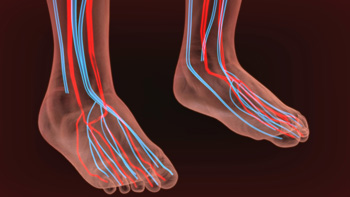
Poor circulation occurs when blood flow through the vessels is reduced, often due to conditions like diabetes, peripheral artery disease, or prolonged inactivity. When circulation is compromised, the feet may feel cold, numb, or tingly and may develop slow-healing wounds or discoloration. These symptoms can increase the risk of infection and make everyday activities more difficult. A podiatrist can assess blood flow, identify underlying causes, and provide treatments to improve circulation and foot health. This may include lifestyle guidance and wound care tips. If you notice changes in your feet, such as temperature shifts, swelling, or sores that do not heal, it is suggested that you visit a podiatrist promptly who can provide a proper diagnosis and treatment.
Poor circulation is a serious condition and needs immediate medical attention. If you have any concerns with poor circulation in your feet contact Gerard Skaziak, DPM of Lakeview Family Foot Care. Our doctor will treat your foot and ankle needs.
Poor Circulation in the Feet
Poor blood circulation in the feet and legs is can be caused by peripheral artery disease (PAD), which is the result of a buildup of plaque in the arteries.
Plaque buildup or atherosclerosis results from excess calcium and cholesterol in the bloodstream. This can restrict the amount of blood which can flow through the arteries. Poor blood circulation in the feet and legs are sometimes caused by inflammation in the blood vessels, known as vasculitis.
Causes
Lack of oxygen and oxygen from poor blood circulation restricts muscle growth and development. It can also cause:
- Muscle pain, stiffness, or weakness
- Numbness or cramping in the legs
- Skin discoloration
- Slower nail & hair growth
- Erectile dysfunction
Those who have diabetes or smoke are at greatest risk for poor circulation, as are those who are over 50. If you have poor circulation in the feet and legs it may be caused by PAD and is important to make changes to your lifestyle in order to reduce risk of getting a heart attack or stroke. Exercise and maintaining a healthy lifestyle will dramatically improve conditions.
As always, see a podiatrist as he or she will assist in finding a regimen that suits you. A podiatrist can also prescribe you any needed medication.
If you have any questions please feel free to contact our offices located in Guntersville and Albertville, AL . We offer the newest diagnostic and treatment technologies for all your foot and ankle needs.
Heel Pain in the Morning?
Early Signs of Rheumatoid Arthritis in the Feet
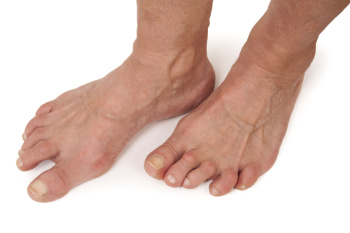
Rheumatoid arthritis in the feet is an autoimmune condition that causes the immune system to attack joint tissues, leading to pain, swelling, and stiffness. It often affects the small joints in the toes and midfoot, making walking painful and limiting mobility. Causes are linked to genetic and environmental factors that trigger inflammation. Symptoms include joint tenderness, warmth, deformities, and a reduced range of motion. Risk factors include a family history of autoimmune conditions, smoking, and age. A podiatrist can help by identifying early changes, providing supportive care with custom orthotics, and footwear advice. If you notice persistent joint pain or swelling in your feet, it is strongly suggested that you promptly visit a podiatrist for an early diagnosis and effective pain management.
Because RA affects more than just your joints, including the joints in your feet and ankles, it is important to seek early diagnosis from your podiatrist if you feel like the pain in your feet might be caused by RA. For more information, contact Gerard Skaziak, DPM of Lakeview Family Foot Care. Our doctor will assist you with all of your podiatric concerns.
What Is Rheumatoid Arthritis?
Rheumatoid Arthritis (RA) is an autoimmune disorder in which the body’s own immune system attacks the membranes surrounding the joints. Inflammation of the lining and eventually the destruction of the joint’s cartilage and bone occur, causing severe pain and immobility.
Rheumatoid Arthritis of the Feet
Although RA usually attacks multiple bones and joints throughout the entire body, almost 90 percent of cases result in pain in the foot or ankle area.
Symptoms
- Swelling and pain in the feet
- Stiffness in the feet
- Pain on the ball or sole of feet
- Joint shift and deformation
Diagnosis
Quick diagnosis of RA in the feet is important so that the podiatrist can treat the area effectively. Your doctor will ask you about your medical history, occupation, and lifestyle to determine the origin of the condition. Rheumatoid Factor tests help to determine if someone is affected by the disease.
If you have any questions please feel free to contact our offices located in Guntersville and Albertville, AL . We offer the newest diagnostic and treatment technologies for all your foot and ankle needs.
Getting the Right Fit on Running Shoes
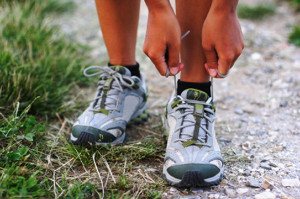
Wearing the right running shoes can help prevent pain and injury by supporting your feet where needed. A proper fit of running shoes starts with choosing a pair that matches your foot shape, length, and width. The toe box should allow enough room to wiggle your toes without pressing them together, while the heel should feel snug without slipping. Your longest toe should have about half an inch of space at the front of the shoe. The midfoot area should hold your arch securely but not feel tight across the sides. It is important to try on shoes using the socks you would normally run in, and later in the day when your feet are naturally more swollen. Shoes that are too tight or loose may lead to blisters, bruised toenails, or more serious foot problems. A podiatrist can help assess your foot shape and gait to recommend proper footwear. If you experience foot pain from running, it is suggested that you schedule an appointment with a podiatrist for an exam and appropriate treatment options.
Finding a properly-fitting shoe is important in reducing injuries and preventing foot problems. For more information about treatment, contact Gerard Skaziak, DPM from Lakeview Family Foot Care. Our doctor will treat your foot and ankle needs.
Proper Shoe Fitting
A common concern when it comes to foot health, having properly fitted shoes can help prevent injuries to the foot. Out feet affect our posture and gait, which in turn affects the biomechanics and overall bodily structure. With 33 joints, 26 bones, and over 100 ligaments, the potential for serious injury is much greater than one realizes. Although the feet cease growth in adulthood, they still change shape as they mature. Here are some factors to consider when it comes to investing in proper fitting shoes:
- Be sure the shoes fit correctly right away
- Ensure the ball of your foot fits comfortably in the widest portion of the shoes
- Even though they may look fashionable, improper fitting shoes can either create adverse conditions or exacerbate existing ones you may already have
- Walk along a carpeted surface to ensure the shoes comfortably fit during normal activity
Keeping in mind how shoes fit the biomechanics of your body, properly-fitting shoes are vitally important. Fortunately, it is not difficult to acquire footwear that fits correctly. Be sure to wear shoes that support the overall structure of your body. Do your feet a favor and invest in several pairs of well-fitted shoes today.
If you have any questions please feel free to contact our offices located in Guntersville and Albertville, AL . We offer the newest diagnostic and treatment technologies for all your foot and ankle needs.
Treating Blisters on the Feet
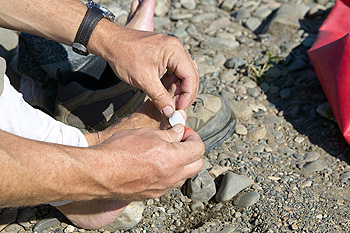
A blister on the foot is a fluid‑filled bubble that forms when the upper skin layers separate and fill with serum. Blisters most often occur on the feet, toes, or ankles due to friction from wearing ill‑fitting footwear, hotspots from repetitive pressure, moisture, or foot shape issues. The body creates blisters as a temporary shield to protect deeper skin and slow down activity by causing discomfort. Clean, dry socks, properly fitted shoes, and keeping the area clean and protected with a dressing or blister pad can speed the process. Popping a blister is unwise because it breaks the natural barrier, which increases the risk of infection and exposes sensitive skin beneath. A podiatrist can assess the extent of the blister, treat any infection, recommend appropriate dressings, and suggest footwear or pressure‑point adjustments to prevent recurrence. If you have problematic blisters on your feet, it is suggested that you schedule an appointment with a podiatrist for safe and sterile treatment.
Blisters may appear as a single bubble or in a cluster. They can cause a lot of pain and may be filled with pus, blood, or watery serum. If your feet are hurting, contact Gerard Skaziak, DPM of Lakeview Family Foot Care. Our doctor can provide the care you need to keep you pain-free and on your feet.
Foot Blisters
Foot blisters are often the result of friction. This happens due to the constant rubbing from shoes, which can lead to pain.
What Are Foot Blisters?
A foot blister is a small fluid-filled pocket that forms on the upper-most layer of the skin. Blisters are filled with clear fluid and can lead to blood drainage or pus if the area becomes infected.
Symptoms
(Blister symptoms may vary depending on what is causing them)
- Bubble of skin filled with fluid
- Redness
- Moderate to severe pain
- Itching
Prevention & Treatment
In order to prevent blisters, you should be sure to wear comfortable shoes with socks that cushion your feet and absorb sweat. Breaking a blister open may increase your chances of developing an infection. However, if your blister breaks, you should wash the area with soap and water immediately and then apply a bandage to the affected area. If your blisters cause severe pain it is important that you call your podiatrist right away.
If you have any questions, please feel free to contact our offices located in Guntersville and Albertville, AL . We offer the newest diagnostic and treatment technologies for all your foot care needs.

